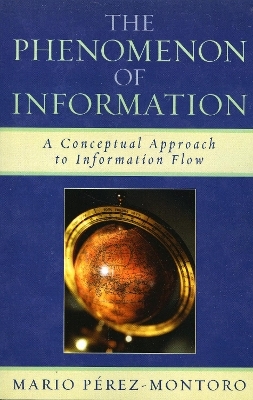
The Phenomenon of Information
Scarecrow Press (Verlag)
978-0-8108-5942-5 (ISBN)
We are surrounded by information. Even the most routine situations in which we find ourselves conceal a hidden information flow. Every step we take, a host of signals meet us, providing information about what is happening in other parts of reality. The cherry tree in bloom reveals that spring has arrived. The footprint left on wet sand indicates that someone has walked along the beach. A red traffic light signals that we must bring our car to a halt. In The Phenomenon of Information, author Mario Pérez-Montoro addresses the problems of providing a theoretical explanation of how a signal carries informational content, how to identify its characteristics, and how to define the mechanisms for describing it. To do this, Pérez-Montoro examines several theoretical approaches to the phenomenon of information: the mathematical theory of communication, Dretske's approach, and the relational theory of meaning. A critique of these efforts leads to the author's definition of informational content, named "the extensional approach," which is designed to overcome the conceptual limitations of the previous theories. The author proposes that his definition might serve as a basis on which a satisfactory analysis of the concept of information can be developed.
Mario Pérez-Montoro is a Professor in the Department of Information Science at the Universitat de Barcelona and IN3 researcher (Internet Interdisciplinary Institute). His work focuses on conceptual, semantic, epistemological and pragmatic aspects of Information Science and Knowledge Management.
Part 1 Acknowledgments Part 2 INTRODUCTION. The Scope and Characteristics of the Phenomenon of Information Chapter 3 1 Introduction Chapter 4 2 Description of Information Flow Chapter 5 3 Aim and Scope of this Work Part 6 CHAPTER 1. The Mathematical Theory of Communication: Constraints for a Semantics of Information Chapter 7 1 Introduction Chapter 8 2 The Amount of Information Chapter 9 3 Amount of Information and Information Flow Chapter 10 4 Mathematical Constraints and Information Content Part 11 CHAPTER 2. Dretske's Analysis of Information: A Semantic Approach in Probabilistic Terms Chapter 12 1 Introduction Chapter 13 2 The Dretskean Approach Chapter 14 3 Difficulties with Dretske's Approach Chapter 15 4 Summary and Conclusions Part 16 CHAPTER 3. The Relational Theory of Meaning: A Proposal for a Global Semantics of Information Chapter 17 1 Introduction Chapter 18 2 A New Conceptual Framework: The Relational Theory of Meaning Chapter 19 3 Linguistic Meaning and Informational Content Chapter 20 4 Agents and Information Content Chapter 21 5 The Relational Theory of Meaning versus Dretske's Definition of Informational Content Chapter 22 6 Reliability, Fallibility, and Constraints Chapter 23 7 Summary and Conclusions Part 24 CHAPTER 4. Toward a New Definition of Informational Content: The Extensional Approach Chapter 25 1 Introduction Chapter 26 2 The Extensional Approach Chapter 27 3 Channels, Reliability, and Fallibility Chapter 28 4 The Extensional Approach versus the Relational Theory of Meaning and the Dretskean Approach Chapter 29 5 Pure Informational Content and Incremental Informational Content Chapter 30 6 Summary and Conclusions Part 31 Bibliography Part 32 Index Part 33 About the Author
| Erscheint lt. Verlag | 11.8.2007 |
|---|---|
| Übersetzer | Dick Edelstein |
| Verlagsort | Lanham, MD |
| Sprache | englisch |
| Maße | 141 x 217 mm |
| Gewicht | 381 g |
| Themenwelt | Mathematik / Informatik ► Informatik ► Theorie / Studium |
| ISBN-10 | 0-8108-5942-4 / 0810859424 |
| ISBN-13 | 978-0-8108-5942-5 / 9780810859425 |
| Zustand | Neuware |
| Informationen gemäß Produktsicherheitsverordnung (GPSR) | |
| Haben Sie eine Frage zum Produkt? |
aus dem Bereich


